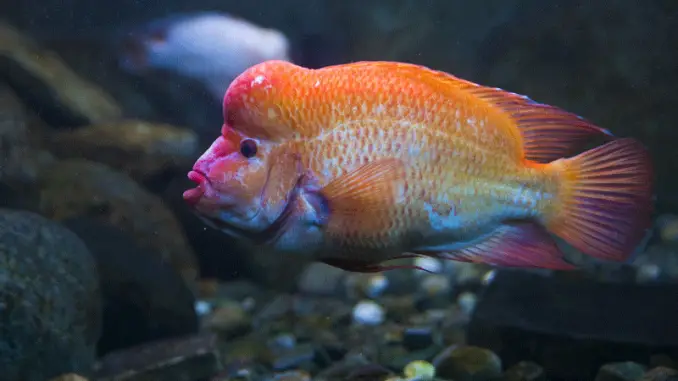
Although red devil fish (also known as red devil cichlids) are extremely aggressive and can pose a threat to other fish in the tank, aquarists still love these large cichlids.
Red devil cichlids are an amazing, freshwater species native to Central America. Their uniquely beautiful appearance, large size, and extreme aggression make them an exciting addition to the aquarium.
In this article, we’ll introduce the red devil cichlid, including its origin, history, natural habitat, and care. We’ll also discuss how to best mitigate the aggressive tendencies of this unique variety of cichlid.
TABLE OF CONTENTS
Red Devil Fish Facts & Overview
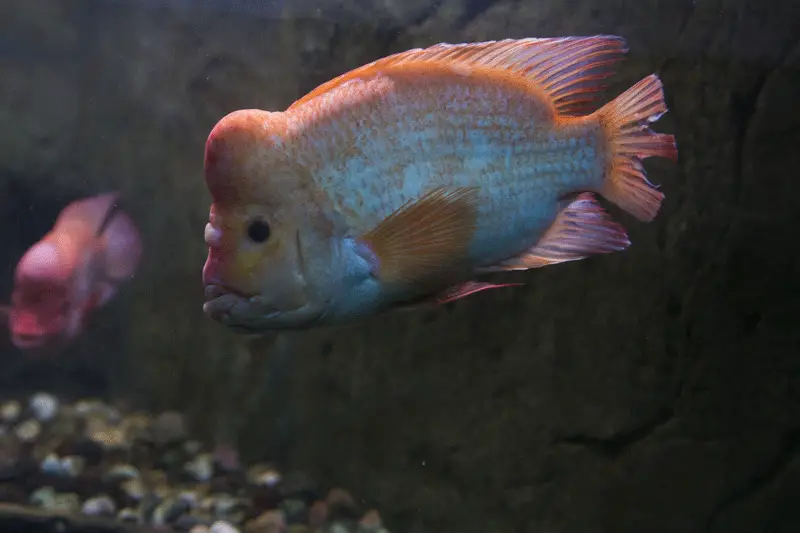
| Category | Rating |
| Care Level: | Difficult |
| Temperament: | Aggressive |
| Color: | Various |
| Lifespan: | 12 years |
| Size: | 15 inches |
| Diet: | Omnivore |
| Family: | Cichlidae |
| Minimum Tank Size: | 55 gallons |
| Tank Setup: | Freshwater with plants and rocks |
| Compatibility: | Solitary |
Native to Lake Managua and Lake Nicaragua in Central America, the red devil cichlid (Amphilophus labiatus) is a large fish that reaches 15 inches (over 38 cm) in length when it is full-grown. The red devil moniker is shared with another related fish, the Amphilophus citrinellus, but this article will focus on the Amphilophus labiatus.
Amphilophus labiatus was originally classified in 1964 as Cichlasoma labiatum by a man by the name of Gunther.
The differences between Amphilophus labiatus and Amphilophus citrinellus (also known as the Midas cichlid) are subtle — in fact, some sources refer to them interchangeably. These distinctions include:
- Size: the red devil cichlid is about 15 inches (38 cm) long, while the Midas ranges from 10″-14″ (25-35 cm).
- Origin: the red devil cichlid is limited to the Nicaraguan lakes: Lago Nicaragua and Lago Managua, while the Midas is seen more widely through Central America, from Costa Rica to Nicaragua.
Fun fact: the red devil cichlid is often also confused with the saltwater Garibaldi damselfish due to their similar appearance, but the red devil is solely a freshwater species.
The red devil cichlid prefers open waters and hangs out among rocks and logs, where it can find a quick hiding place when necessary. In the wild, it is at risk of attack by the bull shark. In your home aquarium, however, the red devil is the predator, and all your other fish are at risk of attack by it.
This is the case in some parts of the wild where the red devil has been introduced into non-native habitats. In Indonesia, for example, it was introduced into the Java, Papua, and Sulawesi Lakes and is now considered to be an invasive fish.
That’s not too surprising considering the red devil is one of the most violent and savage cichlids around. Next, we’ll get into more detail about their vicious behavior.
Typical Behavior
With their big teeth and powerful jaws, red devil cichlids are a force to be reckoned with. Let’s just say that the red devil does not get its name from its appearance but from its personality.
These bottom dwellers dine on other bottom-dwellers like snails, small fish, insect larvae, and worms. That’s food. But as we said, they’re super aggressive and will go after fish for sport, taking off tails or killing them.
At the same time, they quickly grow attached to their owners, who adore them even while acknowledging how mean they are. They ingratiate themselves with their keepers, putting on shows for them, and interacting during mealtime and cleaning time. They’ll even follow you around the room (from inside the tank, of course!)
This attachment is also seen among red devils. Unlike some other species of fish who date and dump, red devils follow the cichlid proclivity to monogamy. They use flattened rocks and logs for spawning.
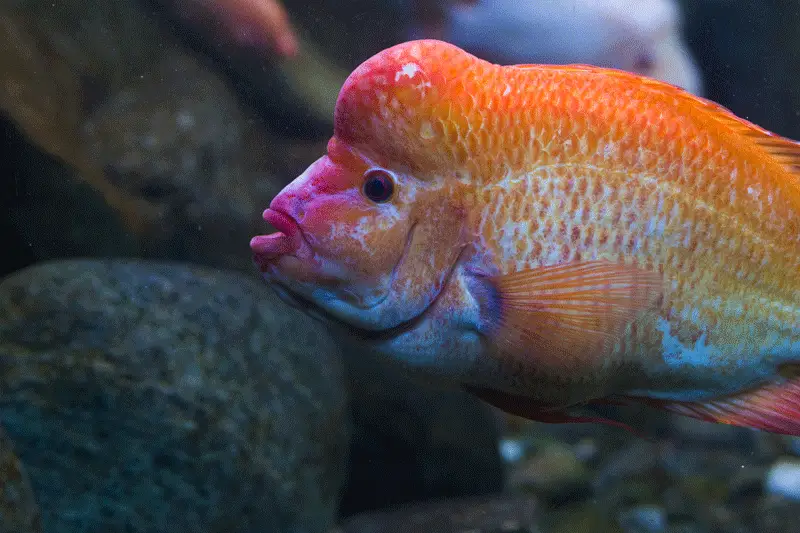 Appearance
Appearance
Red devil cichlids show a wide color variation, from grey to green to white, pink, and red. It is not uncommon to see red devils with black spots or bands on their tails or fins. In the wild, they are sometimes seen with larger lips, but that does not seem to occur in captivity.
We mentioned before that the red devil is among the larger aquarium fish you’ll find, measuring at 15 inches (38 cm). But they are not just long — they are also sturdy creatures that can weigh almost 2.6 pounds (1.2 kg).
Although they reach sexual maturity at about 3 years and 6 inches in length, it takes about 6 years for them to attain their full length.
To distinguish between males and females, look for size first. The males are larger than the females. Additionally, males have two other features: one is a permanent hump on their necks, which is a temporary breeding hump in the red devil’s natural habitat. The second is a genital papilla which is pointed.
Habitat and Tank Conditions
Because red devils are so aggressive, the bigger the tank you can provide, the better. A larger tank can mitigate the level of aggression in the red devils. 55 gallons would be the smallest tank you’d want for red devil cichlids.
Remember that if you’re getting them as young fish, or breeding them, they’re going to be a lot bigger when they grow to maturity. A lot bigger. So you want to make sure their quarters are spacious enough to accommodate them at full size.
Red devil cichlids require a moderate level of care expertise; regular water changes are imperative. In terms of substrate, line the bottom with fine sand and give them rocks and wood to hide.
Giving a vicious 15-inch fish places to hide does sound a little controversial, but remember that these are the conditions that red devils cherish in their native habitat, and a happy fish is a healthy fish, and hopefully, a less crabby fish.
Make sure wood and rocks are anchored in the sand, or your red devils could easily dislodge them. Planning how you will organize and set up your tank is vital, since these large and stubborn fish will likely have their own decorating plans, and will not have a problem disrupting your plans.
While some fish who like hiding places appreciate aquatic plants in their habitat, red devil cichlids will destroy any aquatic plants that you add to your aquarium. They love to dig, so don’t be surprised if you find that the plants you added to your tank are uprooted, demolished, or enjoyed as a snack.
Besides additions to the tank, you should leave space — red devil cichlids are big, so they need more room to swim.
Also keep filters, heaters, and hoses covered and hidden so that the red devils don’t destroy them, too. If you can keep these items on the outside of the tank, that’s ideal.
In terms of lighting, red devil cichlids need normal, moderate lighting — again, keep cords out of their reach.
Water Conditions
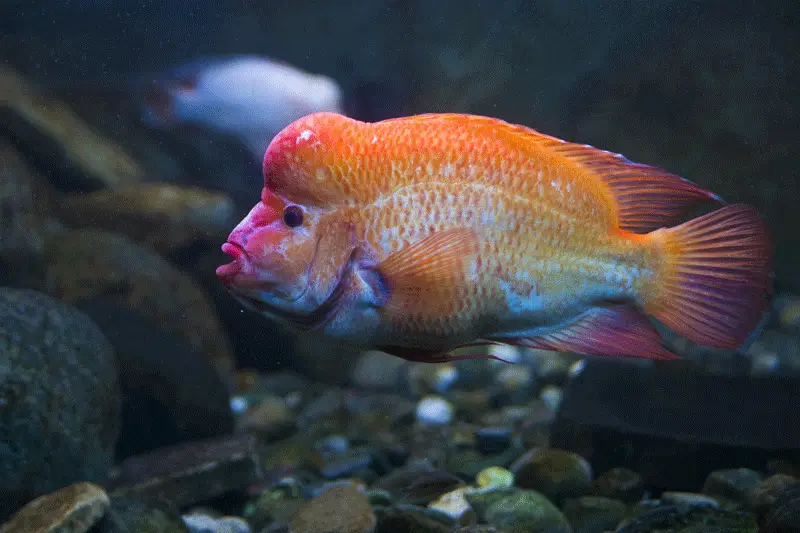
As long as you do regular water changes and keep the tank uber clean, red devils are not super challenging to care for.
Red devil cichlids need stable pH levels and clean water, so it’s important to complete a 25-30% water change weekly. Remember that larger fish create more waste.
When water evaporates, nitrate, and phosphate levels rise; hence, the importance of water changes.
Pro tip: Maintaining oxygen is important for red devils, so try adding a couple of airstones to your aquarium to ensure healthy oxygen levels. You’ll notice a richer color in your red devil cichlids when they have sufficient oxygen.
The optimal parameters to ensure a close match to their natural habitat are:
- pH levels: 6.5-7.5
- Water hardness: 6-25 dGH
- Water current: moderate
- Water temperature: 75-79° F (23.9 to 26.1° C)
What Size Aquarium Do They Need?
Large fish need lots of room, and the red devil cichlid is no exception. You’ll need a tank that is at least 55 gallons if you have one red devil. This tank should have a strong filter and sufficient oxygen, as well as a moderate current.
How Many Red Devils per Gallon?
- One red devil: 55 gallons (208 L)
- Two red devils: 125 gallons (473 L)
- Multiples: 200 gallons (757 L) – A 55-gallon aquarium is the minimum suggested for a single fish, 125 gallons for a pair, and 200 gallons if keeping several large cichlids
Tank Mates
The ferocious nature of the red devil cichlid can not be overstated. An aquarist should always keep the red devil’s true nature in mind when choosing an appropriate tank mate (or choosing whether to have a tank mate at all.)
With their super-strong jaws and sharp teeth, these fish are dangerous. They will not think twice about breaking aquarium equipment, ramming into the glass, and even biting their keepers. Imagine what they can do to other fish.
When red devil cichlids are juveniles, they can be kept with other aggressive fish. However, when they reach adulthood, they do not tolerate tankmates.
You could try a really large tank with lots of space for everyone’s territory, but there is no guarantee that the red devil cichlid will not harm or kill its tankmates. Many aquarists recount stories of their red devils killing other fish.
For that reason, we have to recommend that you keep red devil cichlids in a solitary tank.
Keeping Red Devils Together
Red devil cichlids are not only aggressive to other fish; they also dislike other red devil cichlids. They will do OK if you keep them with their mate (remember, they do attach as a monogamous pair). You will need a very large tank with lots of hiding places if you want to keep two red devils who are not mated.
Diet
Similar to other cichlids, nutrition variety is key for red devil cichlids. They are omnivores, so they will eat pretty much whatever you offer them.
They are predators, so they need rich sources of protein: bloodworms, earthworms, and crickets are good choices. Offer a variety of fresh, freeze-dried, and frozen meat sources.
And despite the fact that they attack and eat other fish, they are not carnivores, so they also need vegetables to balance out their diet and maintain optimal health. Adding vegetables will also protect red devil cichlids from the disease.
Red devil cichlids should be fed several times daily.
Good nutrition sources for red devil cichlids:
- beef heart*
- bloodworms
- carotene
- cichlid pellets
- chicken*
- crickets
- earthworms
- flakes
- krill
- nightcrawlers
- red meat*
- shrimp
- spirulina
*These foods should be offered on occasion, as treats rather than regular menu items
Care
The care of the red devil cichlid is not overly difficult; however, because the tank organization and planning requires experience, and because the red devil is so aggressive, an experienced aquarist is recommended for corralling of this fish.
Red devils have compelling personalities and form attachments with their owners, but the experience of a seasoned aquarist will promote health and wellness for these aggressive cichlids and their tankmates.
Disease
All freshwater fish are at risk of disease and infection if water conditions are not maintained. Red devil cichlids are no exception.
Some common maladies to watch for include:
Hole-in-the-Head disease: This condition is recognizable by the actual holes in your red devil’s head and face. Hole-in-the-Head disease is common in larger cichlids such as red devils. Keeping clean water and making sure it’s not too hard is one way to lower the chance of your Red devil getting this horrible disease.
There is also evidence that Hole-in-the-Head is caused by a nutrition deficiency, so providing a varied and balanced diet is vital.
Ich: Caused by a parasite, ich (Ichthyophthirius multifiliis) is a well-known malady affecting freshwater fish. Ich can be treated with over-the-counter medication. Again, keeping a clean tank reduces the risk of ich, as does creating a stress-free environment for your red devil.
You can reduce stress by:
- keeping the tank clean
- making sure the current and flow is appropriate
- providing hiding spaces
- giving your red devils enough room to both swims and spread out
Other things to watch out for are skin flukes, bacterial infections, fungal infections, and other parasites.
Remember to always quarantine anyone and anything that you are thinking of adding to your aquarium. Any new fish, invertebrate, plant, or decoration could be carrying disease or chemicals into your tank, so take care to mitigate the chance of infection by placing any addition in a holding tank until you can confirm that it is disease-free.
Breeding
Breeding red devil cichlids is not difficult. They spawn 600-700 eggs at a time, and the larvae hatch in approximately 3 days if the water is kept at 77° F (25° C).
Red devils follow the general cichlid practice and spawn in open water. As detailed before, the male and female form an attachment partnership and have a more traditional patriarch/matriarch setup. Once they have established their love connection, you should move them to a breeding tank if you have other fish in your aquarium.
Once in the breeding tank, they will dig a pit and the female will lay the eggs there.
Red devil cichlid eggs have an amber/yellow hue and are transparent. Once the male fertilizes the eggs, the female watches over the eggs. Both the male and female participate in raising the fry.
After hatching, the fry is free swimming in about a week. You can feed the fry Artemia nauplii.
Red devil cichlid fry will also feed off the skin of their parents. Soon they will be big enough to eat live food in small pieces.
Pro-tip: When the larvae hatch and when the fry are developing, it is vital to give the red devil family space. The red devil cichlid parents will do whatever it takes to protect their young. Generally, the females guard the eggs, and the males keep watch over the environment.
Keep in mind that as the red devil cichlid fry grow, you will need a larger tank to accommodate the new fish, and you will need to find sufficient hiding places for everyone.
Are Red Devil Cichlids Suitable for your Aquarium?
After reading this article, you probably know whether or not you are a red devil cichlid kind of person. Certainly, red devils will not disappoint if you are looking to have a fish that you can engage with and that is never boring.
But if you are attached to the other fish in your tank and do not have a desire to risk their life and limb, you may decide that the red devil cichlid is not for you.
Alternatively, you might choose to set up a second tank just for the red devil!
Red Devil Cichlid FAQs
Do I have to feed my red devil cichlids vegetables?
Yes! Red devil cichlids are omnivores. They are often mistaken for carnivores because they are so aggressive with other fish and often eat them. However, they need a variety of different types of food to stay healthy and disease-free. Vegetables and algae actually decrease your red devil cichlid’s chance of contracting Hole-in-the-Head disease (also known as hexamitiasis).
Like humans, red devil cichlids need a balanced diet. A diet that too heavily relies on either protein or greens will lead to vitamin deficiencies, lack of luster in their color, stress, and disease.
Do I need to have a separate breeding tank?
If you have a tank with other fish besides the mating pair, you should separate the pair for mating in a separate aquarium tank. Doing so will ensure the safety of everyone involved, from the red devil cichlid parents to the fry to the other fish in the tank.
You should not move the male and female into a breeding tank until they have paired and formed an attachment. Before attachment, the female is in danger of violence from the male, and she should be protected until the partnership is established.
Once the partnership forms, they can be moved into a breeding tank with a temperature of 77° F (25° C).
I’m just starting my fishkeeping hobby. Would these fish be a good choice?
Due to their aggressive nature and specific water condition needs, we recommend red devil cichlids for seasoned aquarists only. Planning and organizing a tank that ensures the safety of the red devils and their tank mates requires a certain level of expertise and experience.
What is the average lifespan for red devil cichlids?
Red devil cichlids have an average lifespan of 12 years in captivity.
Can I use gravel or rocks for the substrate for my red devil cichlid?
Fine sand is a better choice for red devil cichlids. They are bottom dwellers, and with a rough bottom, they could scrape and injure themselves.
Why do red devil cichlids need hiding places when they are the aggressor?
In their natural environment in the wild lakes of Nicaragua, red devil cichlids are the prey to the freshwater bull shark. In its natural habitat, the red devil cichlid protects itself by finding hiding places.
Even red devils born in captivity have a proclivity for the same kind of environment.
Additionally, providing more hiding places, and in general, more space for swimming and staying away from other fish will result in a red devil cichlid that is less stressed out and less aggressive.
Why does one red devil cichlid need such a large tank?
At 15 inches, these are very large fish and they need space to swim so that they can remain strong. Also, because they are so ferocious, they need room to spread out and have their personal space.

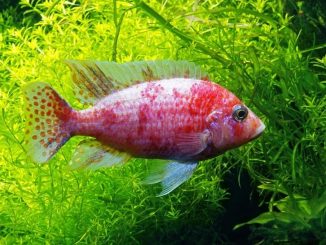
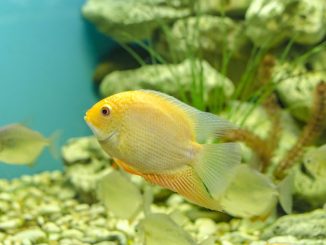
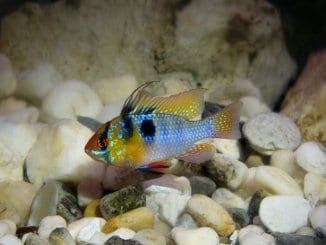

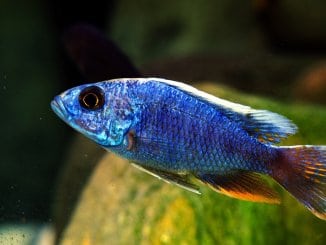
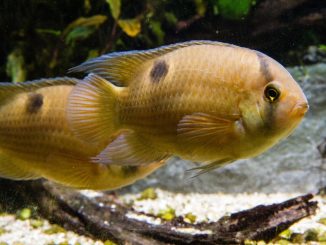
How long do the parents protect their fry from other fish. I have a 125 gallon tank and my Red Devil pair had about 30 Fry that are about an inch long now. The family of Devils are taking up nearly half the tank leaving all the other fish crowded in the other end. What to do?!